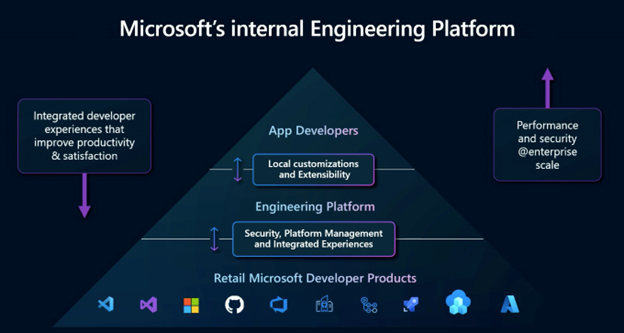Microsoft Build 2024 Highlights Advantages of Platform EngineeringMicrosoft Build 2024 Highlights Advantages of Platform Engineering
Microsoft experts detail how organizations can build out an effective platform engineering team.

While much of the conversations at this week's Microsoft Build conference were focused on generative AI, that's not the only topic that was discussed.
In a session at Microsoft Build 2024, the promise and practices of platform engineering were detailed. The session, titled "Platform Engineering: Creating Scalable and Resilient Systems," provided attendees with practical insights and real-world examples of how platform engineering principles translate into tangible benefits for development teams and organizations at large.
"Platform engineering is really built on top of DevOps," stated Mark Weitzel, principal architect in Microsoft's developers division.
Platform Engineering Moves DevOps Beyond 'Tribal Knowledge'
Weitzel noted that platform engineering makes use of existing DevOps methodologies to enhance the developer experience, security, compliance, and cost control through automation and self-service.
Weitzel highlighted the numerous challenges faced by development teams, including the need to support diverse technology stacks, manage various types of infrastructure, and maintain agility amidst rapid technological advancements.
He pointed out the issue of "tribal knowledge or organizational amnesia," where frequent team changes and the constant influx of new technologies create inconsistencies and expose organizations to increased risks. This scenario often results in suboptimal designs, both in terms of cost and security.
Optimization Through Platform Engineering
The session stressed the importance of optimizing development processes to improve time to business value.
Weitzel shared a real-world example from a customer who faced significant delays in starting a project due to the necessity of coordinating with multiple teams across their organization.
"What should have been a very straightforward process to start a project ended up taking four weeks or so — that’s just too long in today’s environment," he noted.
To address such inefficiencies, platform engineering advocates for the creation of standardized, automated pathways — referred to as "paved paths" — that streamline processes and enhance developer productivity.
The Benefits of Cloud-Native Tooling for Platform Engineering
The session featured demonstrations by Dan Sol, principal product manager at Microsoft Azure, who showcased how platform engineering principles are applied in practice.
In one demo, he detailed the use of Terraform with GitHub Actions to automate the deployment of Azure resources, including AKS clusters, KeyVault, and CosmosDB, enabling developer teams to set up their environments in a self-service manner.
In another demo, Sol demonstrated the use of open source tools like Crossplane and ArgoCD to achieve similar infrastructure and application deployment on a shared AKS cluster. These tools facilitate a cloud-native approach to deployment, leveraging GitOps for declarative configuration management.
The Platform Engineering Journey
Weitzel outlined the steps involved in the platform engineering journey.
Those steps include:
Establishing a platform team
Gaining visibility into the infrastructure and application state
Automating high-toil areas
Using templates to create paved paths
Enabling self-service
Ensuring continuous optimization
It's important to treat platform engineering as a product, adopting strategies akin to product management to ensure successful implementation and adoption, according to Weitzel.
"One of the things that we look at is saying, 'Let's look at the areas of high toil that you have and let's start to automate those,'" he said.
By automating repetitive tasks through repeatable patterns and templates, organizations can facilitate self-service and optimize their development processes.
Weitzel also shared insights into Microsoft’s internal platform engineering mission, which aims to provide a standardized and secure foundation for development teams across the company.

Source: Microsoft
"We have a great advantage in that we can build off our retail products and open source, but we try to take those learnings back and forth between the two," he said.
About the Author
You May Also Like








.jpg?width=700&auto=webp&quality=80&disable=upscale)
